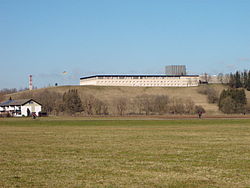Altenstadt Army Air Base
| Altenstadt Army Air Base | |
|---|---|

|
|
| Characteristics | |
| ICAO code | ETHA |
| Coordinates | |
| Height above MSL | 739 m (2425 ft ) |
| Transport links | |
| Distance from the city center | 1.3 km north of Altenstadt |
| Basic data | |
| operator | German army |
| Start-and runway | |
| 09/27 | 700 m × 30 m grass |
The Altenstadt airfield ( Franz-Josef-Strauss barracks ) is used by the Bundeswehr's airborne / air transport training base.
history
The barracks were built from 1937 to 1940 as Flak Artillery School IV according to plans by the architect Robert Roskothen , who was also responsible for the buildings of the Fürstenfeldbruck airfield and the Penzing air base . Initially, soldiers of the Wehrmacht were trained in the barracks in cooperation with the nearby Schongau Air Base on distance measuring and listening devices as well as headlights.
The barracks were abandoned after the Second World War . It was not until the Bundeswehr garrison in Altenstadt was established in 1956 that a small staff took up its service to set up a school for the new German paratroopers from the dilapidated building complex . In February 1958, the air landing and air transport school was able to start training. In 2015 it was renamed “Air Landing / Air Transport Training Base”.
In 2010, the building complex was renovated and expanded with extensive construction work.
In the course of the Bundeswehr reform announced on October 26, 2011, the air landing and air transport school was to be dissolved. However, according to the current status, the training of the parachutists continues to take place in Altenstadt for an indefinite period. Only the name Air Landing and Air Transport School will soon be history, the training content will be retained even after a formal name change. Considerations to move the training to Oldenburg were discarded after extensive examination. Existing buildings will be used in future by a battalion of sergeants and sergeants .
In 2012, the Bavarian State Office for Monument Preservation announced that parts of the facility, which is now owned by the Federal Agency for Real Estate Tasks, are to be placed under monument protection. The inner core of the barracks is affected. In addition to the mess hall, these include the guard building with the St. Michael Hall, the former Luftwaffe headquarters building in the south, the accommodation buildings in the west and east, the farm building that closes off the roll call area in the north and the Munich House, which is separated from the guard building to the east.
Naming
Since 1993 the barracks have been named after the deceased long-time District Administrator of Schongau and Prime Minister of Bavaria Franz Josef Strauss . After he had been promoted to first lieutenant on June 1, 1944 , he was chief of the staff battery and officer for spiritual leadership at the Flak Artillery School IV in Altenstadt .
See also
- List of air bases in Germany
- List of Bundeswehr locations in Germany
- Army Aviation Troops (Bundeswehr)
Individual evidence
- ↑ Altenstadt air landing and air transport school is building for the future. In: merkur.de. Münchner Merkur, August 10, 2010, accessed October 4, 2015 .
- ↑ Hadersbeck fears withdrawal of the federal government at the barracks. In: merkur.de. Münchner Merkur, November 7, 2012, accessed October 4, 2015 .
- ↑ Planned monument protection raises questions. In: Kreisbote.de. Kreisbote, November 11, 2012, accessed October 4, 2015 .
- ↑ Altenstadt - architectural monuments. (pdf) In: geodaten.bayern.de. Bavarian State Office for Monument Preservation, November 27, 2014, accessed October 4, 2015 .
- ↑ Franz Josef Strauss: I confess: The memories of Franz Josef Strauss (II): The way to the politician . In: Der Spiegel . No. 36 , 1989 ( online - 4 November 1989 ).